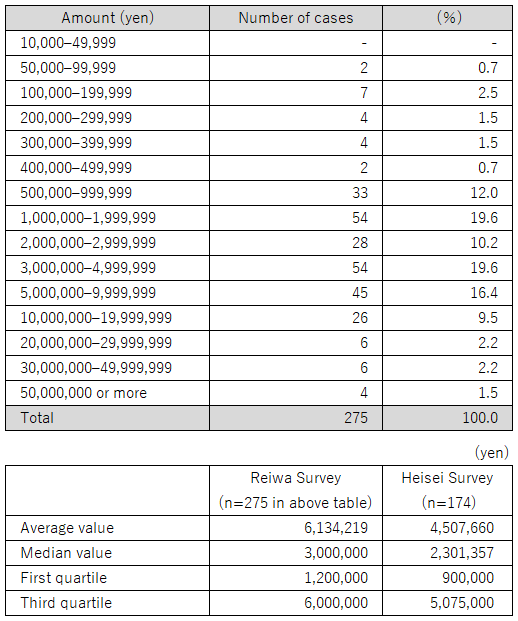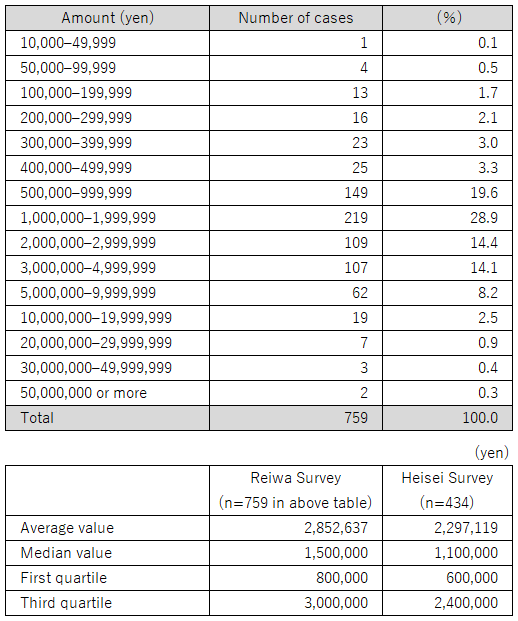JILPT Research Report No.226
Comparative Analysis of Employment Termination Cases Resolved by Labor Tribunals or Court Settlements
April 25, 2023
Summary
Research Objective
The Study Group on Legal Issues concerning the Financial Compensation System for Unfair Dismissal Cases that is conducted by the Ministry of Health, Labour and Welfare (MHLW) compiled a report on the financial compensation system for unfair dismissal cases in April 2022. That same month, the Labor Policy Council’s Working Conditions Committee began discussions on the issue. To contribute to the discussions of the Committee, JILPT conducted a Reiwa Survey in 2022 in response to a request from the MHLW, following the Heisei Survey in 2014 (cf. JILPT Research Report No.174).
Research Method
The data entry of the survey items (They are read-only at a designated place.) was processed at the main office of a district court. These non-public data were a total of approximately 1,200 cases of labor tribunal chotei (mediation) / decision, and court settlement cases, which were closed during the two-year period from 2020 to 2021.
Based on the data entered on the spot we conducted an analysis of various factors, including the attributes of workers, the characteristics (attributes) of the enterprises, the time cost, the content and amount claimed, as well as the content and amount of the resolution or settlement of the cases. Furthermore, we examined the factors that influenced the resolution or settlement amount.
Target groups
- Labor Tribunal:
In 2020 and 2021 calendar years, 785 labor tribunal cases (aiming at confirmation of status, other than for financial compensation) ended in chotei (mediation) or decision (limited to the cases in which no challenge was filed) in a district court (cf. 452 cases in four district courts were examined in the Heisei Survey). - Court settlement:
In 2020 and 2021 calendar years, 282 labor-related civil litigations cases (aiming at confirmation of status, other than for financial compensation) ended in settlement in a district court (cf. 193 cases in four district courts were examined in the Heisei Survey).
Key Findings
1Worker’s attributes
- Gender
The male-female breakdown for court settlement was 174 cases (61.7%) for male and 108 cases (38.3%) for female, and that for labor tribunal was 494 cases (62.9%) and 291 cases (37.1%) respectively, revealing a ratio of a little more than 60% for male and a little less than 40% for female in both cases of court settlements and labor tribunals. There has been a sharp increase in the proportion of female when comparing the Heisei Survey to the Reiwa Survey. - Length of service
The largest difference between the Heisei Survey and the Reiwa Survey is in the length of service. Over the past seven to eight years, the length of service has almost halved both in labor tribunals and court settlements. - Managerial position
Not much change can be observed between the previous Heisei Survey and the Reiwa Survey. In both surveys, in the court settlements nearly 80% of the claimants in the court had no managerial position, while slightly less than 10% were department/plant managers, and about 7% were section/store managers. In the labor tribunals, the percentages of petitioners in non-managerial positions decreased from nearly 90% to slightly over 80%. Accordingly, those of petitioners in the department/plant managers and section/store managers slightly increased. - Employment status
In both court settlements and labor tribunals, the majority of workers are those with indefinite-term labor contracts at nearly 80%, while those with fixed-term labor contracts account for slightly less than 20%, and temporary agency workers account for only less than 2%. - Monthly wage
The distribution of monthly wages has shown a slight increase compared to the previous Heisei Survey. The most common wage band for court settlements was the 200,000-300,000 yen range in the Heisei Survey, but it shifted to the 300,000-400,000 yen range in the Reiwa survey. The most common wage for labor tribunals remained at the 200,000-300,000 yen range in both surveys, while the distribution around that level shifted towards the higher end of the range.
2Firm size (Number of employees)
It was revealed that both court settlements and labor tribunals are used primarily by workers employed in medium, small, and micro enterprises (exceeding initial expectations).
3Time cost
The duration of the proceedings of a litigations filed through settlement tends to be considerably longer than that of a petition filed through resolution for a labor tribunal in both the Heisei and the Reiwa Surveys. However, in both cases of litigations and labor tribunals, the proceedings tend to take slightly longer period in the Reiwa Survey than that in the Heisei Survey. In addition, the time required for resolution also tends to be slightly longer, in line with the longer time required for the proceedings.
4Amount claimed
In terms of median values, the total amount claimed in a court settlement is approximately 8.4 million yen, while that in a labor tribunal is approximately 2.9 million yen.
5Resolution content and resolution amount
- Resolution content
Looking at the resolution content in terms of the confirmation of employment and financial compensation, 272 cases (96.5%) were settled in court, while 758 cases (96.6%) were resolved by labor tribunals, with the overwhelming majority (more than 96%) of these cases being resolved by financial compensation without confirmation of employment in either of court settlement or labor tribunal. - Resolution amount
The resolution amounts for both court settlements and labor tribunals increased significantly in the Reiwa survey, compared to the Heisei Survey (see Tables 1 and 2).
Table 1. Distribution of Court Settlement Resolution Amounts (Reiwa Survey)

Table 2. Distribution of Labor Tribunal Resolution Amounts (Reiwa Survey)

Policy Implications
This research will be used as a material for discussion by the Working Conditions Committee of the Labor Policy Council.
Contents
JILPT Research Report No.226, full text (PDF:1.3MB) [in Japanese]
Category
Research Period
FY2021–2022
Researchers
HAMAGUCHI Keiichiro*Authoring editor Research Director General, JILPT
Fujisawa Miho Research director, JILPT (at the time of research)
For Citation
JILPT. 2022. Rodo shinpan oyobi saiban jo no wakai ni okeru koyo shuryo jian no hikaku bunseki [Comparative analysis of employment termination cases in labor tribunal and court settlement]. JILPT Research Report no.226. Tokyo: The Japan Institute for Labour Policy and Training.
Related Research
- JILPT Research Report No.172, The German System of Monetary Settlement in Cases of Dismissal: Its Legal Framework and Realities (2015)
- JILPT Research Report No.173, Present Situation of the Legal System Governing Dismissal in France (2015)
- JILPT Research Report No.174, Comparative Analysis of Employment Dispute Cases Resolved Labour Bureau Conciliation, Labour Tribunals and Court Settlement (2015)
- Research Material Series No.157, Survey Results on the Individual Labor Disputes Resolution in the United States (2015)
- Yamamoto Yota, Study of Monetary Compensation System for Dismissal in Japan and Germany (2021)
- Fact-finding Research on Financial Compensation for Unfair Dismissal Cases in Court, Japan Labor Issues Vol.8, No.47, Spring 2024 (PDF:6.8MB)
JILPT Research Report at a Glance
| To view PDF files, you will need Adobe Acrobat Reader Software installed on your computer.The Adobe Acrobat Reader can be downloaded from this banner. |

